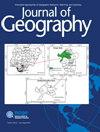Uncommon Sense Teaching: Practical Insights in Brain Science to Help Students Learn
IF 1.8
3区 地球科学
Q1 GEOGRAPHY
引用次数: 5
Abstract
I’ll admit it: I was procrastinating reading Uncommon Sense Teaching: Practical Insights in Brain Science to Help Students Learn. I wanted to read it and had committed to writing this review, but I could never seem to find the time in my workday to just sit down and read. Finally, I decided to read for half an hour first thing every morning with my coffee, before—gasp!—even checking my email. Not only did that work to combat the procrastination, it ironically led me to discover that my new morning routine was in line with the authors’ tips for how to help students stop procrastinating (the “Pomodoro technique”): developing a habit of separating tasks into manageable chunks and setting aside short bursts of time to complete the chunks with no distractions, followed by rest to let the learning sink in. And thus, coffee in hand, my review began to take shape. In Uncommon Sense Teaching, Barb Oakley and colleagues (2021) use brain science principles to explain why the evidence-based teaching strategies used by the best teachers are so effective. The pedagogical approaches themselves—notably active learning, collaborative learning, peer instruction, and instructor presence—may not be new to readers who are well versed in the scholarship of teaching and learning, but what makes this book invaluable is the way the authors describe the science of how our brains work when learning. The authors then relate the science to practical strategies that instructors at any level can use to harness that brain function in their teaching to help students master a subject. In this way, the book complements ideas from the excellent 2010 text How Learning Works by Susan Ambrose and others. Engaging, too, is the authors’ combination of neuroscience research with personal anecdotes from years of teaching experience. Two of the book’s authors, Barbara Oakley and Terrence Sejnowski, are the creators of the massive open online course “Learning How to Learn,” which is rated 4.8 stars out of 5 according to almost 75,000 reviews. The third, Beth Rogowski, is both an education professor and a neuroscience researcher. Together, the authors put their substantial combined expertise to use in Uncommon Sense Teaching with treatment of timely topics that include student motivation, knowledge retention, and inclusive teaching. Perhaps most instructional for these times is the chapter on online teaching, which offers concrete tips for delivering an effective and engaging online course using both synchronous and asynchronous learning, something that all of us could have desperately used during the early stages of the COVID-19 pandemic and will likely continue to need in the future. The target audience for this book leans more toward K–12 education than higher education, but college and university instructors can still glean useful teaching and course design strategies. Although it does not have a geography education focus, the material in Oakley and colleagues’ book is applicable to any discipline and will be appreciated by both physical and human geography instructors. There is perhaps an overreliance on detailed analogies to get points across; I tired quickly of the repeated reference to the working memory “octopus” with its anthropomorphized brain counterparts. Outweighing the book’s weaknesses are its many strengths, which include the reiterated emphasis of the “learn it–link it” model to explain how students learn in different contexts; the “now you try” tips that help the reader put each chapter’s concepts into practice (incidentally, also following the learn it–link it model, but for the reader); and the key ideas summarized at the end of each chapter that act as quick reference guides. The overall flow of the book is captivating, and the sheer amount of useful information begets many dog-eared pages and margin notes, if (like me) you’re that sort of reader. Experienced instructors will find themselves with several “aha” moments as they read, either in recognizing why what they do works or why it does not. Inexperienced instructors will gain a wealth of information about how their students learn and how they can best facilitate that learning. If done well, teaching can be both a science and an art. Uncommon sense teaching gives us the knowledge and tools to achieve both.非凡的感官教学:帮助学生学习的脑科学实践见解
我承认:我一直在拖延阅读《常识教学:帮助学生学习的脑科学实践见解》。我很想读这本书,并承诺要写这篇评论,但我似乎从来没有在我的工作日里找到时间坐下来阅读。最后,我决定每天早上第一件事就是边喝咖啡边读半个小时的书。——甚至检查我的电子邮件。这不仅有效地克服了拖延症,讽刺的是,它还让我发现,我新的晨间安排与作者关于如何帮助学生停止拖延症的建议(“番茄工作法”)是一致的:养成一种习惯,把任务分成可管理的小块,留出一小段时间来不受干扰地完成这些小块,然后休息一下,让学习完全进入状态。就这样,手里拿着咖啡,我的评论开始成形了。在《非凡教学》一书中,Barb Oakley及其同事(2021)利用脑科学原理解释了为什么优秀教师使用的循证教学策略如此有效。教学方法本身——尤其是主动学习、合作学习、同伴指导和教师在场——对于精通教学和学习学术的读者来说可能并不新鲜,但使这本书变得无价的是作者描述我们的大脑在学习时如何工作的科学方式。然后,作者将科学与实用策略联系起来,任何水平的教师都可以在教学中利用大脑功能来帮助学生掌握一门学科。通过这种方式,这本书补充了苏珊·安布罗斯和其他人在2010年出版的优秀著作《学习是如何工作的》中的观点。同样引人入胜的是,作者将神经科学研究与多年教学经验中的个人轶事相结合。这本书的两位作者,Barbara Oakley和Terrence Sejnowski,是大型开放在线课程“学习如何学习”的创造者,根据近75,000条评论,该课程获得了4.8星(满分5分)的评价。第三位是Beth Rogowski,她既是教育学教授,也是神经科学研究员。在一起,作者把他们的实质性的综合专业知识运用到非同寻常的教学处理及时的主题,包括学生的动机,知识保留,和包容性的教学。也许这段时间最有指导意义的是在线教学一章,该章提供了使用同步和异步学习提供有效和引人入胜的在线课程的具体技巧,我们所有人在COVID-19大流行的早期阶段都可能迫切需要这些技巧,并且可能在未来继续需要这些技巧。这本书的目标读者更倾向于K-12教育,而不是高等教育,但学院和大学教师仍然可以收集有用的教学和课程设计策略。虽然这本书没有地理教育的重点,但Oakley及其同事的书中的材料适用于任何学科,并且将受到自然地理学和人文地理学教师的赞赏。也许过于依赖详细的类比来表达观点;我很快就厌倦了反复提到工作记忆“章鱼”和它拟人化的大脑对应物。这本书的优点超过了缺点,其中包括反复强调“学习它-链接它”模式,以解释学生如何在不同的环境中学习;“现在你试试”的技巧,帮助读者将每章的概念付诸实践(顺便说一句,也遵循学习-链接-模型,但对读者来说);并在每一章的最后总结了关键的思想,作为快速参考指南。这本书的整体流程是迷人的,如果你(像我一样)是那种读者,那么大量有用的信息就会产生许多皱巴巴的页面和空白处的注释。有经验的教师会发现自己在阅读的过程中会有几次“啊哈”的时刻,要么认识到他们所做的事情为什么有效,要么为什么不有效。没有经验的教师将获得丰富的信息,关于他们的学生如何学习,以及他们如何最好地促进学习。如果做得好,教学可以既是一门科学也是一门艺术。常识教学为我们提供了实现这两个目标的知识和工具。
本文章由计算机程序翻译,如有差异,请以英文原文为准。
求助全文
约1分钟内获得全文
求助全文
来源期刊

Journal of Geography
GEOGRAPHY-
CiteScore
4.90
自引率
6.50%
发文量
12
期刊介绍:
Journal of Geography is the journal of the National Council for Geographic Education. The Journal of Geography provides a forum to present innovative approaches to geography research, teaching, and learning. The Journal publishes articles on the results of research, instructional approaches, and book reviews.
 求助内容:
求助内容: 应助结果提醒方式:
应助结果提醒方式:


